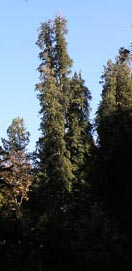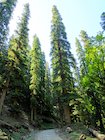Conservation Status

Abies pindrow
(Royle ex D. Don) Royle 1839
Common names
West Himalayan fir, Pindrow fir, pindrau [Himachal], badar [Kashmir], rahga [Kumaon] (Farjon 2010).
Taxonomic notes
A species in Abies section Momi, subsection Holophyllae, otherwise comprised of firs distributed from SW China to SE Russia. Syn: Pinus pindrow Royle ex D. Don 1836; A. webbiana (Wall. ex D. Don.) Lindl. var. pindrow (Royle ex D. Don) Brandis 1874. Type: illustration in Royle (1839).
Many authorities recognize a variety, A. pindrow (Royle ex D. Don) Royle var. brevifolia Dallim. & A. B. Jacks. 1923, which is here treated as A. gamblei Hickel, for reasons discussed on that species' page.
A hybrid with A. spectabilis, A. pindrow (Royle ex D. Don) Royle var. intermedia A. Henry, has also been described (Vidakovic 1991), but this appears to be inaccurate; the two species are not sympatric, A. spectabilis typically occurring at substantially higher elevations (ca. 500 m) in areas where the species co-occur (Farjon 2010, Farjon and Filer 2013).
Description
Trees to 60 m tall and 300 cm DBH, typically with a single straight, round trunk, short branches and a narrow, conical crown. Bark first smooth and gray, becoming thick, gray-brown and longitudinally furrowed. Buds globose, large, and resinous. Twigs stiff, pinkish to pale brown, soon fading to pale gray, glabrous, lightly ridged, with circular leaf scars. Leaves spirally arranged but appearing roughly 2-ranked on shade foliage, the upper leaves somewhat shorter than the lower, 3-6 cm × 1.3-2 mm, twisted at base, flattened, grooved and dark green above, with 2 gray stomatal bands below; no stomata on upper surface; apex bifid or emarginate or obtuse, but acute on coning shoots. Pollen cones lateral, numerous, on underside of shoots, 10-15 mm long, yellow-brown when active. Seed cones lateral, erect, on short peduncles, cylindrical with obtuse apex, 10-14 × 5-6 cm, first violet blue, at maturity dark red-brown, with flabellate seed scales 25-35 × 30-40 mm having a slightly striated surface and entire upper margin; bracts hidden. Seeds 10-12 long with a 15-20 mm brown wing (Vidakovic 1991, Farjon 2010). See García Esteban et al. (2004) for a detailed characterization of the wood anatomy.
Distribution and Ecology
Throughout the western Himalaya, in Afghanistan, Pakistan, India, and Nepal, at elevations of 2000-3300(-3700) m; climate is monsoonal, cool and moist, increasingly snow-dominated from the western to eastern range limits. Occurs in pure stands, but is also often codominant with Pinus wallichiana, Picea smithiana, or Cedrus deodara, and less frequently occurs with Tsuga dumosa; at lower elevations broadleaf angiosperms become progressively dominant, replacing the conifers at elevations below 1600 m (Vidakovic 1991; Farjon 2010; Siddiqui et al. 2013, 2015). Bioclimatic modeling of an area in Pakistan indicates that global climate change is likely to lead to future reductions in the species (Ali et al. 2014 ). Hardy to Zone 8 (cold hardiness limit between -12.1°C and -6.7°C) (Bannister and Neuner 2001).
Firs of the southern Himalaya. Abies pindrow (var. pindrow) in blue, A. spectabilis in green, and A. densa in red. Data source is Conifers of the World (accessed 2019.05.16). Note that A. gamblei is not shown; it occurs locally in India: Himachal Pradesh and Uttarakhand.
Remarkable Specimens
Vladimir Dinets (e-mail 2004.11.14) reports trees in Ayubia National Park, Pakistan, growing up to 60 m tall.
The oldest known specimen is documented in a tree-ring chronology covering the period 1505-2005 (crossdated after 1509), collected in the mountains northeast of Islamabad, Pakistan by Ed Cook, Jon Palmer, and Moinuddin Ahmed (doi.org/10.25921/3ndg-ce49). The oldest tree in the study provided a 483-year record. Most of the sampled trees were dead; perhaps they had been logged. This collection was used in a dendroclimatic study of regional temperature variation (PAGES 2k Consortium 2013).
Ethnobotany
In traditional medicine, foliar extracts were used as anti-inflammatories (Singh et al. 2000). This is an important timber tree in its range, the wood used mainly for construction of interiors (floors, stairs, etc.). It is also used in box-making (Farjon 2010).
Some exploratory work in dendrochronology has been done in Pakistan, India, and Nepal, leading to development of chronologies going back to as early as 1650. The trees do crossdate and show response to climate variation (Ahmed 1989, Thapa et al. 2013, Ram and Borgaonkar 2014).
Observations
Vladimir Dinets (2004), traveling in Pakistan, recounts: "I left the most pleasant part of the trip until the end. There is a town called Muree in the mountains above Islamabad. It used to be a British hill station. and is still surrounded by forest. A narrow, densely forested ridge with a few villages goes north for almost fifty kilometers. It is by far the largest forest in the country, now protected as Ayubia National Park. The British built a network of hiking trails between the villages. They are broad, level, and often equipped with handrails. The forest is mostly old growth Indian white pine [Pinus wallichiana], but on northern slopes there are groves of very tall, slender West Himalayan firs [Abies pindrow], with some huge Sumatran yews [Taxus contorta] and deodars [Cedrus deodara]."
Remarks
The epithet is one of the common names for this tree in India.
Pests of A. pindrow include the aphid Adelges knucheli (Schneider and Schneider 1954), and it is subject to the root rot Fusarium oxysporum f.sp. pini (Dar et al. 2013).
Citations
Ahmed, Moinuddin. 1989. Tree-ring chronologies of Abies pindrow (Royle) Spach, from Himalayan region of Pakistan. Pakistan Journal of Botany 20(2):347-354.
Ali, K., Ahmad, H., Khan, N. and Jury, S. 2014. Future of Abies pindrow in Swat district, northern Pakistan. Journal of Forestry Research 25(1):211-214.
Dar, W.A., Beig, M.A., Ganie, S.A., Bhat, J.A. and Razvi, S.M. 2013. In vitro study of fungicides and biocontrol agents against Fusarium oxysporum f. sp. pini causing root rot of Western Himalayan fir (Abies pindrow). Scientific Research and Essays 8(30):1407-1412.
Dinets, Vladimir. 2004. Ramadan in Pakistan. http://dinets.travel.ru/eibex.htm, accessed 2004.11.28, now defunct.
Farjon, A. and D. Filer. 2013. An Atlas of the World's Conifers: An Analysis of their Distribution, Biogeography, Diversity, and Conservation Status. Leiden, Netherlands: Brill Academic Publishers.
PAGES 2k Consortium. 2013. Continental-scale temperature variability during the past two millennia. Nature Geoscience 6:339-346. doi: 10.1038/NGEO1797
Ram, S. and Borgaonkar, H.P. 2014. Climatic response of various tree ring parameters of fir (Abies pindrow) from Chandanwadi in Jammu and Kashmir, western Himalaya, India. Current Science 106(11):1568-1576.
Royle, J.F. 1839. Illustrations of the Botany and other Branches of the Natural History of the Himalayan Mountains, and of the Flora of Cashmere 1: p. 350, t. 86. Available: https://biodiversitylibrary.org/page/2913102, accessed 2019.08.03.
Schneider, O. and Schneider, F. 1954. Adelges in A. pindrow in the NW Himalaya. Mitteilungen der Schweizerischen Entomologischen Gesellschaft, Lausanne 27(4):413-422.
Siddiqui, M. F., S. S. Shaukat, M. Ahmed, N. Khan, and I. A. Khan. 2013. Vegetation-environment relationship of conifer dominating forests of moist temperate belt of Himalayan and Hindukush regions of Pakistan. Pakistan Journal of Botany 45(2):577–592.
Siddiqui, M. F., M. Ahmed, M. I. Hussain, J. Iqbal, and M. Wahab. 2015. Present state and future trends of pine forests of Malam Jabba, Swat District, Pakistan. Pakistan Journal of Botany 47(6):2161–2169.
Singh, R.K., Bhattacharya, S.K. and Acharya, S.B. 2000. Pharmacological activity of Abies pindrow. Journal of Ethnopharmacology 73(1-2):47-51.
Thapa, U.K., Shah, S.K., Gaire, N.P., Bhuju, D.R., Bhattacharyya, A. and Thagunna, G.S. 2013. Influence of climate on radial growth of Abies pindrow in western Nepal Himalaya. Banko Janakari 23(2):14-19.
See also
Elwes and Henry 1906-1913 at the Biodiversity Heritage Library. This series of volumes, privately printed, provides some of the most engaging descriptions of conifers ever published. Although they only treat species cultivated in the U.K. and Ireland, and the taxonomy is a bit dated, still these accounts are thorough, treating such topics as species description, range, varieties, exceptionally old or tall specimens, remarkable trees, and cultivation. Despite being over a century old, they are generally accurate, and are illustrated with some remarkable photographs and lithographs.
Farjon, Aljos. 1990. Pinaceae: drawings and descriptions of the genera Abies, Cedrus, Pseudolarix, Keteleeria, Nothotsuga, Tsuga, Cathaya, Pseudotsuga, Larix and Picea. Königstein: Koeltz Scientific Books.
- Provides a detailed account, with illustrations.




